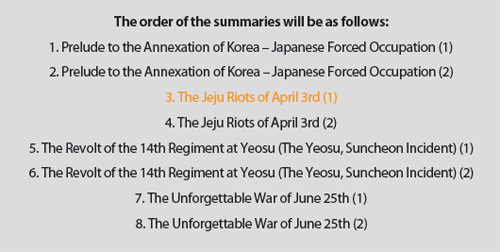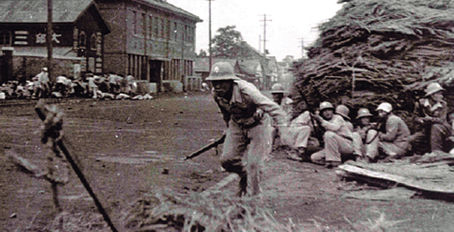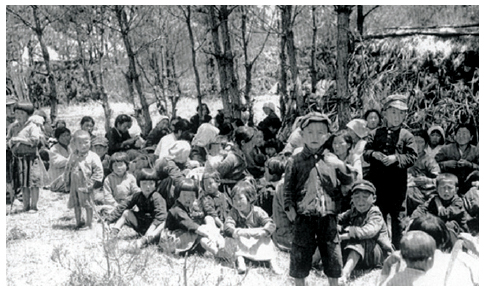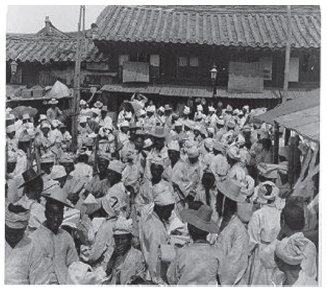|
Special Project - Having an Accurate Understanding of Korea’s Modern History
|
|
|
글쓴이 :
관리자
|
|
Special Project
Having an Accurate Understanding of Korea’s Modern History
The history of Korea plays a part in our own history as individuals. The person who does not know his or her nation’s history cannot establish a proper identity. Moreover, Korea’s modern history is a setting that shows God’s sovereignty and His providential intervention, that He does not rest for one minute or even a second in order to bring redemption to mankind. At a time when humanistic discourses that distort and trivialize this history are rife in our midst, Senior Pastor Abraham Park has published an account of Korea’s modern history entitled A Series on the Modern History of Korea, a fourbooklet series, through Huisun. Through this series, future generations will be able to obtain a correct and righteous view of their own history founded on God-centeredness. Champyungan will summarize the contents of the booklet series over eight monthly issues.

1. Early Communism in Korea
After the March 1st Movement in 1919, the nation’s expectations about the restoration of its sovereignty peaked; however, Japan’s oppression got worse. In the midst of such circumstances, communism was able to lure many people to its side. It was the time when communism began to spread worldwide as the Bolshevik Revolution led by Vladimir Lenin had succeeded in November 1917. Under the leadership of the Soviet Union, the Communist Party of Korea threw their full support for all types of liberation movements in hopes of drawing the nation into communism. That was how communism sneaked into Korea not only among patriots but also for the general public.
The organizer of the communization was Park Hon-young. On April 17, 1925, six years after the March 1st Movement, the Communist Party was established by about twenty activists including Park Hon-young, Kim Jae-bong, Yoon Byung-dok, Kim Yak-soo.
2. The spread of communism after Independence
(1) Korea divided along the 38th parallel.
After the atom bomb was dropped on Hiroshima and Nagasaki on August 6th and 9th of 1945, Soviet soldiers invaded Manchuria and moved toward the Korean peninsula. United States, worried that the whole peninsula might be occupied by the Soviet Union, drew the line at the 38th parallel and agreed to have Soviet Union receive the surrender from Japan north of the line and the US would receive the surrender from Japan south of the 38th parallel.
(2) Appearance of Park Hon-young and the establishment of the People’s Republic of Korea
Caught between Communism and Liberal Democracy, the Republic of Korea was ideologically in chaos and disorder after its liberation. Sleeping communists in Korea and returning communists from abroad became activated. On August 17, 1945, Yuh Woon-hyung, an activist in Korea, was able to promptly form the biggest political organization named the Committee for Preparation of Korean Independence. Soon afterwards, Park Hon-young’s Chosun Community Party incorporated Yuh’s committee and established the People’s Republic of Korea on September 6.
However, the disclosure of the counterfeit money production, which the Communist party had plotted since October 1945, became the decisive incident that would curtail the rapidly spreading influence of the Communist party. As a result, the leader Park Hon-young fled from the United States Military Government and took refuge in North Korea while still controlling communist party members and fraktsiyas (moles) from behind the scenes?getting them to lead many rebellions and uprisings. A representative one is the Autumn uprising which took place on October 1, 1946 in Daegu.

3. The Autumn uprising on October 1, 1946 in Daegu.
(1) Background
Long before the uprising, Korea already suffered food shortages.
While food rationing had been carried out by the U.S. Military Government, as the price of rice soared, anti-American sentiment was prevalent. The Workers Party of South Korea agitated the public to hold anti-America protests so that they can cover up Park Hon-young’s counterfeiting incident.
It was on October 1, 1946 when thousands of workers flocked the Daegu station in order to protest against the U.S. Only 150 policemen were on guard, some protesters from the second floor of Daegu station abruptly started stoning the guards yelling “Kill the police!” In response to the raid, police shot into the second floor office killing a demonstrator named Hwang Mal-yong who was a coal briquette factory worker. The news that the police killed a citizen spread quickly. And the leftists quickly assembled all of the laborers on October 2.
At 9:00 am, October 2, four apprentices from Daegu medical university hospital stole four corpses of patients who had died from Cholera covered them with white sheets. The leftists stirred up the youth saying that the dead bodies were victimized by policemen at the Daegu station the day before. At 10:00 a.m. they arrived in the police station. A leader of the leftists began to negotiate by saying that he would dismiss the protest if the chief of Daegu police station, Lee Sung-ok, ordered his men to disarm. Chief Lee naively believed the leader’s words and ordered his men to disarm.
The protesters quickly proceeded to raid the police station and took over.
(2) Uprising spreads through the north and south Gyeongsang Provinces, south Jeolla Province and the rest of the nation
Chosun Communist Party rioters divided themselves into groups of 50-100, drove cars they stole, and broke into 22 police stations and civil offices located in north Gyeongsang Province. Daegu became a hotbed of fear and unrest after the communist rioters turned violent and arbitrarily slaughtered policemen with their blades and axes. The Chosun Communist Party capitalized on the repercussions of the Daegu Autumn uprising, ordered each local branch to organize ‘guerilla’ forces and the uprising swiftly spread to 73 cities where all kinds of mayhem and brutality ensued.
(3) Impact of the Daegu October 1st Uprising
The Daegu autumn uprising sparked a mass killing of 38 policemen, 163 civil workers, and 73 civilians.
Also, it caused the injuries to one thousand people and destruction of 776 buildings. The uprising in Daegu was put down, but the instigators of the riots hid themselves in Mt. TaeBaek and SoBaek and created camps named ‘Yasan Dae’, the first organization of the Korean partisans.
The Workers Party of North Korea was founded at a congress on October 28, 1946 chaired by Kim Il Sung. The Workers Party of South Korea was founded on November 23, 1946 under the leadership of Pak Hon-young. The two communist parties of north and south Korea came into existence. Kim Il Sung came to establish his own regime the ‘Democratic People’s Republic of North Korea’ by drafting their own constitution on February 6, 1948 and printing their own currency.

4. The Jeju April 3rd uprising in 1948
(1) Southernmost part of Korean peninsula, Communist organization in Jeju
Jeju is located 141.6 km from Mokpo and 286.5 km from Busan. Due to this geographical characteristic which makes it hard to be controlled, many pro-North leftist movements had occurred in Jeju since the liberation. Chosun Communist Party Jeju Council was established on December 9, 1945, which constitutes only leftists and this changed its name to the Workers Party of South Korea Jeju Council on November 23, 1946. Except the Military police, intelligence agency and the police, majority of Jeju islanders joined the party without knowing the doctrine or political line of the party.
It was the communists’ world after all. Even though Jeju was under the United States military government, Jeju Council was the actual self-governing body of the entire Jeju Island, and the Workers Party of South Korea was the puppet master.
(2) Jeju March 1st shooting incident
The March 1st Movement memorial ceremony in 1948 sparked many conflicts between pro-trusteeship and anti-trusteeship and the Right and the left wings. In Jeju Island, there was no possibility of clashes between the right and the left wings because there were so few rightists. So ultimately, the leftists clashed with the police.
anti-police sentiment among the public. Eventually, the Workers Party of South Korea instigated general strikes in 156 organizations of 41,211 people who belonged to all the administrative organizations, schools, companies, banks, transportation agencies, and communications organizations.
In order to put down the April Jeju uprising, the United States Military Government dismissed the police Lee Moon-kyu who actually fired a shot, and also had the island’s governor, chief prosecutor, and chief inspector step down. That was how the general strikes were wrapped up.
(3) February 7th Uprising to obstruct the May 10 Election
In February 1948, South Korea’s election date was confirmed to be held on May 10, 1948, in order to establish the Republic of Korea. Park Hon-young, who was eager to communize the entire Korean peninsula, worked hard to stop the election by inciting insurgencies on February 7 and April 3.
On February 7, 1948, the Workers Party of South Korea started the belligerent “February 7th Uprising” by mobilizing three hundred thousand of its members all over the country. Bridges were broken, transportation, telegraphic communication, and telephone companies went on strikes, and South Korea’s administrative bodies were not able to function properly. In Seoul and other provinces, some students went on strikes under the command of the “Democratic Students Union,” and farmers and workers attacked police stations. In Jeju Island, since the dawn of February 7, people broke into the police stations and started fired and slaughtered many police officers. They were reorganized as the “People’s Liberation Army,” armed with rifles, grenades, Japanese-swords, and bamboo-spears. They became rioters; buried police officers alive and killed marshals. The “February 7th Uprising” continued for two weeks. The rioters set up bases all over the Halla Mountain and went ahead for the April 3rd Uprising.
Summary by reporter Ji Geun-ook

|
|

